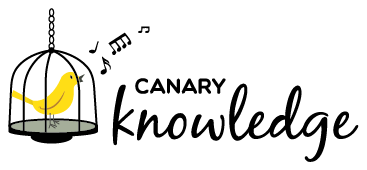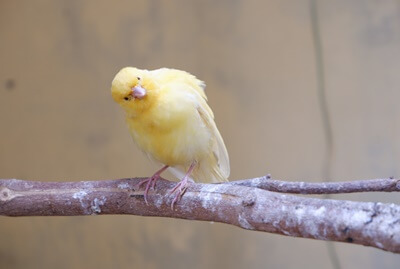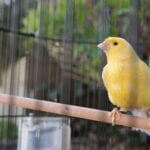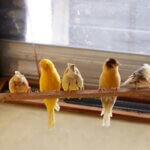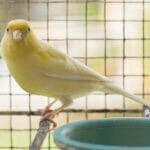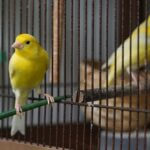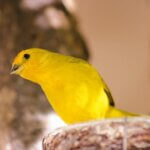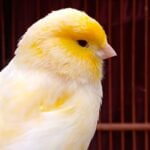Last Updated on: 4th October 2022, 07:15 pm
It’s normal for a canary to lose its feathers when molting. However, feather loss can signify stress, illness, excessive preening, and self-destructive behaviors like feather plucking.
Since canaries molt once a year (usually in the summer), environmental factors, such as longer daylight hours and high temperatures, can trigger unseasonal molting. In some cases, poor nutrition and stress may also lead a canary to molt for longer than it should.
If you notice your canary is losing feathers that aren’t due to molting, check for other signs and symptoms.
Why Do Canaries Lose Feathers?
Losing feathers is normal for canaries, similar to how humans lose hair throughout their lives. You should also find large, mostly intact feathers in your canary’s cage once a year.
At other times, losing feathers signifies a health problem. This is the case if it’s sudden, has no connection to molting, or if your canary is experiencing other symptoms.
Here are the main reasons why canaries shed feathers and what can be done:
1/ Molting
If you’re wondering, “why do canaries lose their tail feathers?” or, “why is my canary losing feathers on its head?” molting is usually the cause. Your canary will lose most of its feathers during this time, usually in succession rather than all at once.
Molting is a natural phenomenon that all canaries undergo. Canaries molt once a year, usually in the middle of summer, when daytime temperatures increase and the daylight hours begin to decrease.
During the molting season, you’ll find the canary molting old feathers and replacing them with new ones. This allows them to rejuvenate their plumage and shed broken or damaged feathers.
The molting process lasts 6- 8 weeks, although it can continue for up to 12 weeks. The signs of a healthy molt include the following:
- Reduced singing in male canaries due to being physically drained.
- More feathers at the bottom of the canary’s cage.
- New pin feathers on the canary’s body, including the chest, head, and wings.
- More lethargic and tired than usual.
- Frequent preening of feathers.
Canary fledglings usually go through a partial molt (also known as soft molt) once they reach 2 months of age. During this period, they replace all their feathers except those on their wings and tails.
Once they mature into adults and complete their first breeding season, they go through a full molt. Here, they replace all their feathers, including the wings and tails.
After that, canaries will continue to molt fully at around the same time every year, at the end of each breeding season.
2/ Stress
If you’re wondering, “why do canaries pull out their feathers?” stress is a likely cause. Canaries are even-tempered but also shy and skittish, making them prone to stress, which can trigger abnormal molting.
Stressed canaries are likely to engage in self-destructive behaviors, such as feather plucking and aggressive preening. This will cause their feathers to fall out. Common stressors include:
- Inadequate diet (malnutrition)
- Change of environment, such as cage relocation
- Inadequate or interrupted sleep
- Overcrowded cage
- Disease and infection
- Injury
- Noisy environment
- Boredom, or a lack of physical and mental stimulation
- Nearby predators
Diagnosing stress in canaries isn’t easy because the symptoms of stress may overlap with other illnesses. However, if your canary’s feathers are falling out, look for:
- Loss of appetite
- Increased screaming or screeching
- Self-mutilation
- Stress bars on feathers
- Fear
If you notice these signs, check your canary’s environment for stressors. In most cases, canaries stressed by external factors will regain their composure once the issue has been resolved.
For instance, if your canary is stressed due to aggression and bullying from a cage mate, transferring it to a separate cage will make it feel more comfortable and relaxed.
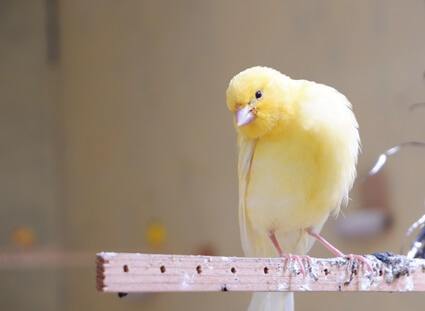
3/ Illnesses and Feather Problems
You’ll sometimes care for your canary well, and it’ll still lose feathers. If it happens outside of the molting season, or the molting season takes far longer, it may have a bacterial or viral illness.
Those illnesses and diseases known to cause feather loss in canaries include:
Psittacine circoviral disease (also known as beak and feather disease) is a viral illness in canaries. Infected birds experience chronic feather loss and feather discoloration.
During the early stages, the affected canaries may regrow new feathers to replace the ones that have fallen out. However, these new feathers are abnormally-shaped and break off easily at the base.
As the disease progresses, infected canaries can’t grow new feathers and may be unable to shed old feathers. Others experience abnormal beak and nail growth, leading to deformation.
According to the Encyclopedia of Agriculture and Food Systems, PCD causes immunosuppression (weakened immune system), making it difficult for affected canaries to fight off worse illnesses.
For this reason, canaries infected are more susceptible to secondary bacterial infections that cause death.
Unfortunately, once the virus infects a canary, it’ll lose its feathers and may become bald. The disease can’t be cured but can be managed with veterinary assistance.
Avian Polyomavirus (APV)
Polyomavirus is transmitted by direct exposure to infected birds. Although it’s more common in Psittaciformes (parrot species), canaries are susceptible to a lesser extent.
According to the Journal of Veterinary Research, fledglings have a high risk of APV and suffer worse symptoms than older birds. While it can also affect adult birds, it rarely causes death.
The common symptoms of avian polyomavirus include:
- Feather loss
- Abnormal feather growth
- Bleeding of feather follicles
- Lack of appetite
- Subcutaneous bleeding
- Paleness
APV also causes immunosuppression, leaving the affected canaries vulnerable to secondary infections.
Since it’s fatal, you must take the necessary precautions to ensure it doesn’t occur in the first place. This involves cleaning and disinfecting the cage and quarantining infected canaries.
4/ External Parasites
Canaries are prone to external parasites, such as mites and fleas. Most of these parasites embed under the feathers and survive by feeding on their skin and consuming blood.
This causes discomfort and irritation, which may force the canary to scratch itself aggressively, leading to its feathers falling off.
Your vet might recommend a bird-safe insecticide to kill the parasites. You may also need to isolate the affected canary throughout treatment to ensure it doesn’t spread the parasites.
5/ Malnourishment
Canaries require protein for the growth and development of healthy feathers. After all, canary feathers are made up of keratin, which is the same protein found in human hair and nails.
Consequently, inadequate protein in a canary’s diet causes the development of weak feathers that fall off easily. This can be remedied by giving your parrot protein-rich foods or supplements, such as:
- Hard-boiled eggs
- Bean mixtures
- Mealworms
6/ Feather Plucking
While it’s not uncommon for canaries to pluck their feathers when stressed, this isn’t the only reason parrots engage in this behavior.
When they have an illness or injury, canaries sometimes pluck their feathers to self-soothe. Also, a canary may pluck its feathers when feeling bored or lonely.
7/ Excessive Preening
While it’s normal for a canary to preen several times a day when grooming, excessive preening causes breakages to the canary’s feathers and damages the skin. Too much preening can be triggered by:
- Dry skin
- Boredom
- Poor diet
- Obesity
- Lack of exercise
- Hormonal imbalances
8/ Skin Irritation
Low humidity can make a canary’s skin dry up and crack. When this happens, the canary’s feathers may detach from the follicles and fall off.
Likewise, canaries are prone to allergies that may cause their skin to become scaly and itchy. As a result, the affected canary might scratch itself aggressively to soothe itself, causing feather loss.
